Assessment of Non-Linear Analyses of RC Buildings Retrofitted with Hysteretic Dampers According to the Italian Building Code
Abstract
:1. Introduction
2. RC Case Study Structures
3. Design of the Seismic Retrofit
4. OpenSees Numerical Model
5. Selection of the Accelerograms for the Non-Linear Time-History Analyses
6. Results of Non-Linear Analyses
- NLSAs provided accurate estimates of forces for both buildings (maximum deviation +15% in the study), and the accuracy was virtually unaffected by the ductility of the dampers.
- NLSAs are not accurate when the structural performance is evaluated referring to displacements and deformations, e.g., maximum displacements between adjacent buildings or inter-story drifts. Only for low values (μDB = 3) and in some cases even medium–low values (μDB = 5) of ductility of the dissipative bracing system the estimates provided by NLSAs are fair, while the accuracy deteriorates as the damping capacity of the bracing systems increases. These estimates are always on the conservative side, but there is a potential concern of ending up with a design that is overly conservative.
- Focusing on the outcomes in terms of maximum displacements at the top floor, the study is unable to provide conclusive results, as deviations from the benchmark range from −30% to +200% depending on the building type, seismic scenario, and characteristics of the dissipative bracing system. However, as previously highlighted, the general trend shows that the accuracy of results deteriorates as μDB increases. Moreover, in the six-story building, NLSAs with underestimate the displacement for low μDBs (≤5) and overestimate it for high μDBs.
- NLTHA,N generally underestimate the demand values in terms of forces and displacements, often by up to 30%. This underestimation occasionally shows a modest reduction with increasing μDBs. In some cases, e.g., for μDB = 3, there is even an overestimation of the maximum displacement and maximum inter-story drift. It is important to emphasize that in this study, the results of NLTHA,N are referred to as benchmark. However, both NLTHA,N and NLTHA,A are considered equivalent according to the IBC [30].
7. Conclusions
- When referring to the calculation of the total base shear forces, NLSAs can provide acceptable results at significantly lower computational cost compared to NLTHAs. Therefore, they can be suitable when the effectiveness of the retrofit design is evaluated comparing internal actions with capacities; the accuracy of the analyses seems to be not substantially affected by the mechanical characteristics of dissipative braces;
- NLSAs provide fair predictions of inter-story drift only for dampers with low or moderate–low ductility (e.g., μDB ≤ 5); the accuracy quickly deteriorates as μDB increases, and the error can be higher than 100% when μDB ≥ 10. Even in case, in derogation to the code, a damping reduction factor η < 0.55 is considered, the deviation can be unacceptable, leading to an extremely overconservative design;
- The study was unconclusive regarding the accuracy of NLSAs in predicting absolute displacements, even if it suggests that the analyses underestimate the displacement for small μDBs and overestimate for high μDBs;
- Results of NLTHAs are significantly affected by the set of accelerograms used, either artificial or natural, with absolute deviations on the order of up to 30%; the consistency between the analyses depends on the characteristics of the building and of the examined seismic scenario.
Author Contributions
Funding
Data Availability Statement
Conflicts of Interest
References
- Bruschi, E.; Quaglini, V.; Calvi, P.M. A Simplified Design Procedure for Seismic Upgrade of Frame Structures Equipped with Hysteretic Dampers. Eng. Struct. 2022, 251, 113504. [Google Scholar] [CrossRef]
- Zoccolini, L.; Bruschi, E.; Cattaneo, S.; Quaglini, V. Current Trends in Fluid Viscous Dampers with Semi-Active and Adaptive Behavior. Appl. Sci. 2023, 13, 10358. [Google Scholar] [CrossRef]
- Quaglini, V.; Pettorruso, C.; Bruschi, E. Experimental and Numerical Assessment of Prestressed Lead Extrusion Dampers. Ing. Sismica 2021, 38, 46–68. [Google Scholar]
- Quaglini, V.; Pettorruso, C.; Bruschi, E. Design and Experimental Assessment of a Prestressed Lead Damper with Straight Shaft for Seismic Protection of Structures. Geosciences 2022, 12, 182. [Google Scholar] [CrossRef]
- Bruschi, E.; Zoccolini, L.; Cattaneo, S.; Quaglini, V. Experimental Characterization, Modeling, and Numerical Evaluation of a Novel Friction Damper for the Seismic Upgrade of Existing Buildings. Materials 2023, 16, 1933. [Google Scholar] [CrossRef] [PubMed]
- Bruschi, E.; Quaglini, V. Assessment of a Novel Hysteretic Friction Damper for the Seismic Retrofit of Reinforced Concrete Frame Structures. Structures 2022, 46, 793–811. [Google Scholar] [CrossRef]
- Terenzi, G. Novel Design Procedure for Steel Hysteretic Dampers in Seismic Retrofit of Frame Structures. Eng. Struct. 2023, 284, 115969. [Google Scholar] [CrossRef]
- Dolce, M.; Cardone, D.; Marnetto, R. Implementation and Testing of Passive Control Devices Based on Shape Memory Alloys. Earthq. Eng. Struct. Dyn. 2000, 29, 945–968. [Google Scholar] [CrossRef]
- Nabid, N.; Hajirasouliha, I.; Escolano Margarit, D.; Petkovski, M. Optimum Energy Based Seismic Design of Friction Dampers in RC Structures. Structures 2020, 27, 2550–2562. [Google Scholar] [CrossRef]
- Ferraioli, M.; Lavino, A. A Displacement-Based Design Method for Seismic Retrofit of RC Buildings Using Dissipative Braces. Math. Probl. Eng. 2018, 2018, 5364564. [Google Scholar] [CrossRef]
- Lavan, O.; Dargush, G.F. Multi-Objective Evolutionary Seismic Design with Passive Energy Dissipation Systems. J. Earthq. Eng. 2009, 13, 758–790. [Google Scholar] [CrossRef]
- Palermo, M.; Silvestri, S.; Gasparini, G.; Trombetti, T. Crescent Shaped Braces for the Seismic Design of Building Structures. Mater. Struct. 2015, 48, 1485–1502. [Google Scholar] [CrossRef]
- Segovia, V.A.; Ruiz, S.E. Direct Displacement-Based Design for Buildings with Hysteretic Dampers, Using Best Combinations of Stiffness and Strength Ratios. J. Earthq. Eng. 2017, 21, 752–775. [Google Scholar] [CrossRef]
- Symans, M.D.; Charney, F.A.; Whittaker, A.S.; Constantinou, M.C.; Kircher, C.A.; Johnson, M.W.; McNamara, R.J. Energy Dissipation Systems for Seismic Applications: Current Practice and Recent Developments. J. Struct. Eng. 2008, 134, 3–21. [Google Scholar] [CrossRef]
- Nuzzo, I.; Losanno, D.; Caterino, N. Seismic Design and Retrofit of Frame Structures with Hysteretic Dampers: A Simplified Displacement-Based Procedure. Bull. Earthq. Eng. 2019, 17, 2787–2819. [Google Scholar] [CrossRef]
- EN 15129; Anti-Seismic Devices. CEN (European Committee for Standardization): Brussels, Belgium, 2009.
- Ponzo, F.C.; Di Cesare, A.; Arleo, G.; Totaro, P. Protezione sismica di edifici esistenti con controventi dissipativi di tipo isteretico: Aspetti progettuali ed esecutivi. Progett. Sismica 2010, 1, 37–60. [Google Scholar]
- Mazza, F. Nonlinear Seismic Analysis of Unsymmetric-Plan Structures Retrofitted by Hysteretic Damped Braces. Bull. Earthq. Eng. 2016, 14, 1311–1331. [Google Scholar] [CrossRef]
- Antonucci, R.; Balducci, F.; Castellano, M.G.; Donà, F. Pre-casted RC buildings with buckling restrained braces: The example of the new building of the faculty of engineering in Ancona. In Proceedings of the Second International fib Congress, Napoli, Italy, 5–8 June 2006; p. 879. [Google Scholar]
- Terenzi, G. Energy-Based Design Criterion of Dissipative Bracing Systems for the Seismic Retrofit of Frame Structures. Appl. Sci. 2018, 8, 268. [Google Scholar] [CrossRef]
- Freddi, F.; Tubaldi, E.; Zona, A.; Dall’Asta, A. Seismic Performance of Dual Systems Coupling Moment-Resisting and Buckling-Restrained Braced Frames. Earthq. Eng. Struct. Dyn. 2021, 50, 329–353. [Google Scholar] [CrossRef]
- Freddi, F.; Ghosh, J.; Kotoky, N.; Raghunandan, M. Device Uncertainty Propagation in Low-Ductility RC Frames Retrofitted with BRBs for Seismic Risk Mitigation. Earthq. Eng. Struct. Dyn. 2021, 50, 2488–2509. [Google Scholar] [CrossRef]
- Gutiérrez-Urzúa, F.; Freddi, F. Influence of the Design Objectives on the Seismic Performance of Steel Moment Resisting Frames Retrofitted with Buckling Restrained Braces. Earthq. Eng. Struct. Dyn. 2022, 51, 3131–3153. [Google Scholar] [CrossRef]
- Belleri, A.; Marini, A.; Riva, P.; Nascimbene, R. Dissipating and Re-Centring Devices for Portal-Frame Precast Structures. Eng. Struct. 2017, 150, 736–745. [Google Scholar] [CrossRef]
- Ke, K.; Yam, M.C.H.; Zhang, P.; Shi, Y.; Li, Y.; Liu, S. Self-Centring Damper with Multi-Energy-Dissipation Mechanisms: Insights and Structural Seismic Demand Perspective. J. Constr. Steel Res. 2023, 204, 107837. [Google Scholar] [CrossRef]
- Yang, F.; Wang, G.; Li, M. Evaluation of the Seismic Retrofitting of Mainshock-Damaged Reinforced Concrete Frame Structure Using Steel Braces with Soft Steel Dampers. Appl. Sci. 2021, 11, 841. [Google Scholar] [CrossRef]
- Durucan, C.; Dicleli, M. Analytical Study on Seismic Retrofitting of Reinforced Concrete Buildings Using Steel Braces with Shear Link. Eng. Struct. 2010, 32, 2995–3010. [Google Scholar] [CrossRef]
- Garivani, S.; Askariani, S.S.; Aghakouchak, A.A. Seismic Design of Structures with Yielding Dampers Based on Drift Demands. Structures 2020, 28, 1885–1899. [Google Scholar] [CrossRef]
- Zare Golmoghany, M.; Zahrai, S.M. Improving Seismic Behavior Using a Hybrid Control System of Friction Damper and Vertical Shear Panel in Series. Structures 2021, 31, 369–379. [Google Scholar] [CrossRef]
- Italian Council of Public Works. Technical Standards on Constructions; Italian Council of Public Works: Rome, Italy, 2018. (In Italian) [Google Scholar]
- Italian Council of Public Works. Commentary on the Technical Standards on Constructions; Italian Council of Public Works: Rome, Italy, 2019. (In Italian) [Google Scholar]
- Mander, T.J.; Rodgers, G.W.; Chase, J.G.; Mander, J.B.; MacRae, G.A.; Dhakal, R.P. Damage Avoidance Design Steel Beam-Column Moment Connection Using High-Force-to-Volume Dissipators. J. Struct. Eng. 2009, 135, 1390–1397. [Google Scholar] [CrossRef]
- Desombre, J.; Rodgers, G.W.; MacRae, G.A.; Rabczuk, T.; Dhakal, R.P.; Chase, J.G. Experimentally Validated FEA Models of HF2V Damage Free Steel Connections for Use in Full Structural Analyses. Struct. Eng. Mech. 2011, 37, 385–399. [Google Scholar] [CrossRef]
- Rodgers, G.W.; Solberg, K.M.; Mander, J.B.; Chase, J.G.; Bradley, B.A.; Dhakal, R.P. High-Force-to-Volume Seismic Dissipators Embedded in a Jointed Precast Concrete Frame. J. Struct. Eng. 2012, 138, 375–386. [Google Scholar] [CrossRef]
- Rodgers, G.W.; Solberg, K.M.; Chase, J.G.; Mander, J.B.; Bradley, B.A.; Dhakal, R.P.; Li, L. Performance of a Damage-protected Beam–Column Subassembly Utilizing External HF2V Energy Dissipation Devices. Earthq. Eng. Struct. Dyn. 2008, 37, 1549–1564. [Google Scholar] [CrossRef]
- Rodgers, G.W.; Chase, J.G.; Mander, J.B. Repeatability and High-Speed Validation of Supplemental Lead-Extrusion Energy Dissipation Devices. Adv. Civ. Eng. 2019, 2019, 7935026. [Google Scholar] [CrossRef]
- Bommer, J.J.; Acevedo, A.B. The use of real earthquake accelerograms as input to dynamic analysis. J. Earthq. Eng. 2004, 8, 43–91. [Google Scholar] [CrossRef]
- Manfredi, V.; Masi, A.; Özcebe, A.G.; Paolucci, R.; Smerzini, C. Selection and Spectral Matching of Recorded Ground Motions for Seismic Fragility Analyses. Bull. Earthq. Eng. 2022, 20, 4961–4987. [Google Scholar] [CrossRef]
- EN 1998–1; Design of Structures for Earthquake Resistance—Part 1: General Rules, Seismic Actions and Rules for Building. European Committee for Standardization: Brussels, Belgium, 2005.
- Faleschini, F.; Zanini, M.A.; Toska, K. Seismic Reliability Assessment of Code-Conforming Reinforced Concrete Buildings Made with Electric Arc Furnace Slag Aggregates. Eng. Struct. 2019, 195, 324–339. [Google Scholar] [CrossRef]
- Bruschi, E.; Quaglini, V.; Zoccolini, L. Seismic Upgrade of Steel Frame Buildings by Using Damped Braces. Appl. Sci. 2023, 13, 2063. [Google Scholar] [CrossRef]
- Ponzo, F.C.; Di Cesare, A.; Telesca, A.; Pavese, A.; Furinghetti, M. Advanced Modelling and Risk Analysis of RC Buildings with Sliding Isolation Systems Designed by the Italian Seismic Code. Appl. Sci. 2021, 11, 1938. [Google Scholar] [CrossRef]
- Bruschi, E.; Quaglini, V. Reliability Analysis of Two Archetype RC Buildings with Hysteretic Dampers. Soil Dyn. Earthq. Eng. 2024, 176, 108290. [Google Scholar] [CrossRef]
- Di Cesare, A.; Ponzo, F.C. Seismic Retrofit of Reinforced Concrete Frame Buildings with Hysteretic Bracing Systems: Design Procedure and Behaviour Factor. Shock. Vib. 2017, 2017, 2639361. [Google Scholar] [CrossRef]
- Castaldo, P.; Tubaldi, E.; Selvi, F.; Gioiella, L. Seismic Performance of an Existing RC Structure Retrofitted with Buckling Restrained Braces. J. Build. Eng. 2021, 33, 101688. [Google Scholar] [CrossRef]
- Scozzese, F.; Gioiella, L.; Dall’Asta, A.; Ragni, L.; Tubaldi, E. Influence of Viscous Dampers Ultimate Capacity on the Seismic Reliability of Building Structures. Struct. Saf. 2021, 91, 102096. [Google Scholar] [CrossRef]
- McKenna, F.; Fenves, G.L.; Scott, M.H. Open System for Earthquake Engineering Simulation; Pacific Earthquake Engineering Research Center, University of California: Berkeley, CA, USA, 2003; Available online: http://opensees.berkeley.edu (accessed on 31 January 2024).
- OpenSeesWiki Online Manual. Available online: https://opensees.berkeley.edu/wiki/index.php/Main_Page (accessed on 31 January 2024).
- Bruschi, E.; Calvi, P.M.; Quaglini, V. Concentrated Plasticity Modelling of RC Frames in Time-History Analyses. Eng. Struct. 2021, 243, 112716. [Google Scholar] [CrossRef]
- Scott Michael, H.; Fenves Gregory, L. Plastic Hinge Integration Methods for Force-Based Beam–Column Elements. J. Struct. Eng. 2006, 132, 244–252. [Google Scholar] [CrossRef]
- Popovics, S. A numerical approach to the complete stress-strain curve of concrete. Cem. Concr. Res. 1973, 3, 583–599. [Google Scholar] [CrossRef]
- EN 1998–3; Design of Structures for Earthquake Resistance—Part 3: Assessment and Retrofitting of Buildings. CEN (European Committee for Standardization): Brussels, Belgium, 2005; Eurocode 8.
- Menegotto, M.; Pinto, P.E. Method of analysis for cyclically loaded RC plane frames including changes in geometry and non-elastic behaviour of elements under combined normal force and bending. In Proceedings of the IABSE: Symposium on Resistance and Ultimate Deformability of Structures Acted on by Well Defined Repeated Loads, Lisboa, Portugal, 13–14 September 1973. Final Report. [Google Scholar]
- Filippou, F.C.; Popov, E.P.; Bertero, V.V. Effects of Bond Deterioration on Hysteretic Behavior of Reinforced Concrete Joints; Report EERC 83-19; Earthquake Engineering Research Center, University of California: Berkeley, CA, USA, 1983. [Google Scholar]
- Barbagallo, F.; Bosco, M.; Marino, E.M.; Rossi, P.P. On the Fibre Modelling of Beams in RC Framed Buildings with Rigid Diaphragm. Bull. Earthq. Eng. 2020, 18, 189–210. [Google Scholar] [CrossRef]
- Mazzoni, S.; McKenna, F.; Scott, M.H.; Fenves, G.L.; Jeremic, B. OpenSEES Command Language Manual; Pacific Earthquake Engineering Research Center, University of California: Berkeley, CA, USA, 2003. [Google Scholar]
- Barbagallo, F.; Bosco, M.; Marino, E.M.; Rossi, P.P.; Stramondo, P.R. A Multi-performance Design Method for Seismic Upgrading of Existing RC Frames by BRBs. Earthq. Eng. Struct. Dyn. 2017, 46, 1099–1119. [Google Scholar] [CrossRef]
- Gandelli, E.; De Domenico, D.; Quaglini, V. Cyclic Engagement of Hysteretic Steel Dampers in Braced Buildings: A Parametric Investigation. Bull. Earthq. Eng. 2021, 19, 5219–5251. [Google Scholar] [CrossRef]
- Gandelli, E. Seismic Retrofit of Hospitals by Means of Hysteretic Braces: Influence on Acceleration-Sensitive Non-Structural Components. Front. Built Environ. 2019, 5, 100. [Google Scholar] [CrossRef]
- SIMQKE (SIMulation of earthQuaKE Ground Motions). Available online: https://gelfi.unibs.it/software/simqke/simqke_gr.htm (accessed on 31 January 2024).
- Ambraseys, N.N.; Smit, P.; Douglas, J.; Margaris, B.; Sigbjörnsson, R.; Ólafsson, S.; Suhadolc, P.; Costa, G. Internet Site for European Strong-Motion Data. Boll. Geofis. Teor. Appl. 2004, 45, 113–129. [Google Scholar]
- Iervolino, I.; Galasso, C.; Cosenza, E. REXEL: Computer Aided Record Selection for Code-Based Seismic Structural Analysis. Bull. Earthq. Eng. 2010, 8, 339–362. [Google Scholar] [CrossRef]
- CRESME Ricerche. Incentivi e Riduzione del Rischio Sismico in Italia; Ingegneria Sismica Italiana: Rome, Italy, 2020. (In Italian) [Google Scholar]
- Ke, K.; Zhang, H.; Zhou, X.; Yam, M.C.H.; Wang, Y.; Shi, T. Hybrid-Self-Centring Steel Frames: Insights and Probabilistic Seismic Assessment. Eng. Struct. 2024, 303, 117516. [Google Scholar] [CrossRef]
- Zhang, H.; Zhou, X.; Ke, K.; Yam, M.C.H.; He, X.; Li, H. Self-Centring Hybrid-Steel-Frames Employing Energy Dissipation Sequences: Insights and Inelastic Seismic Demand Model. J. Build. Eng. 2023, 63, 105451. [Google Scholar] [CrossRef]
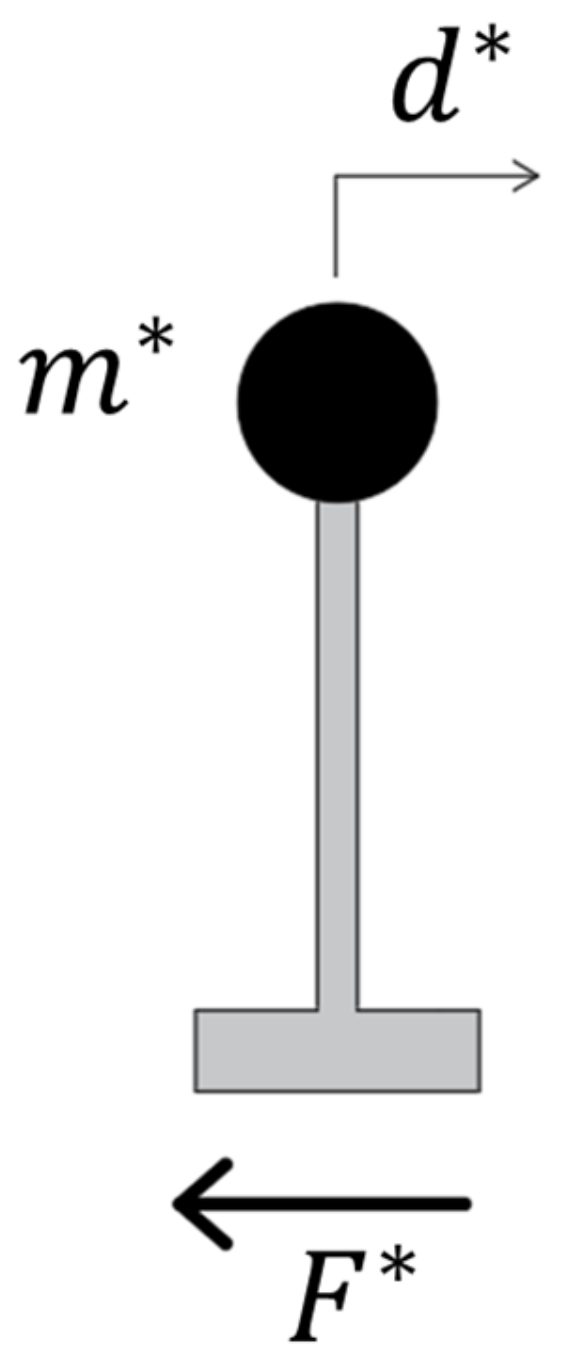
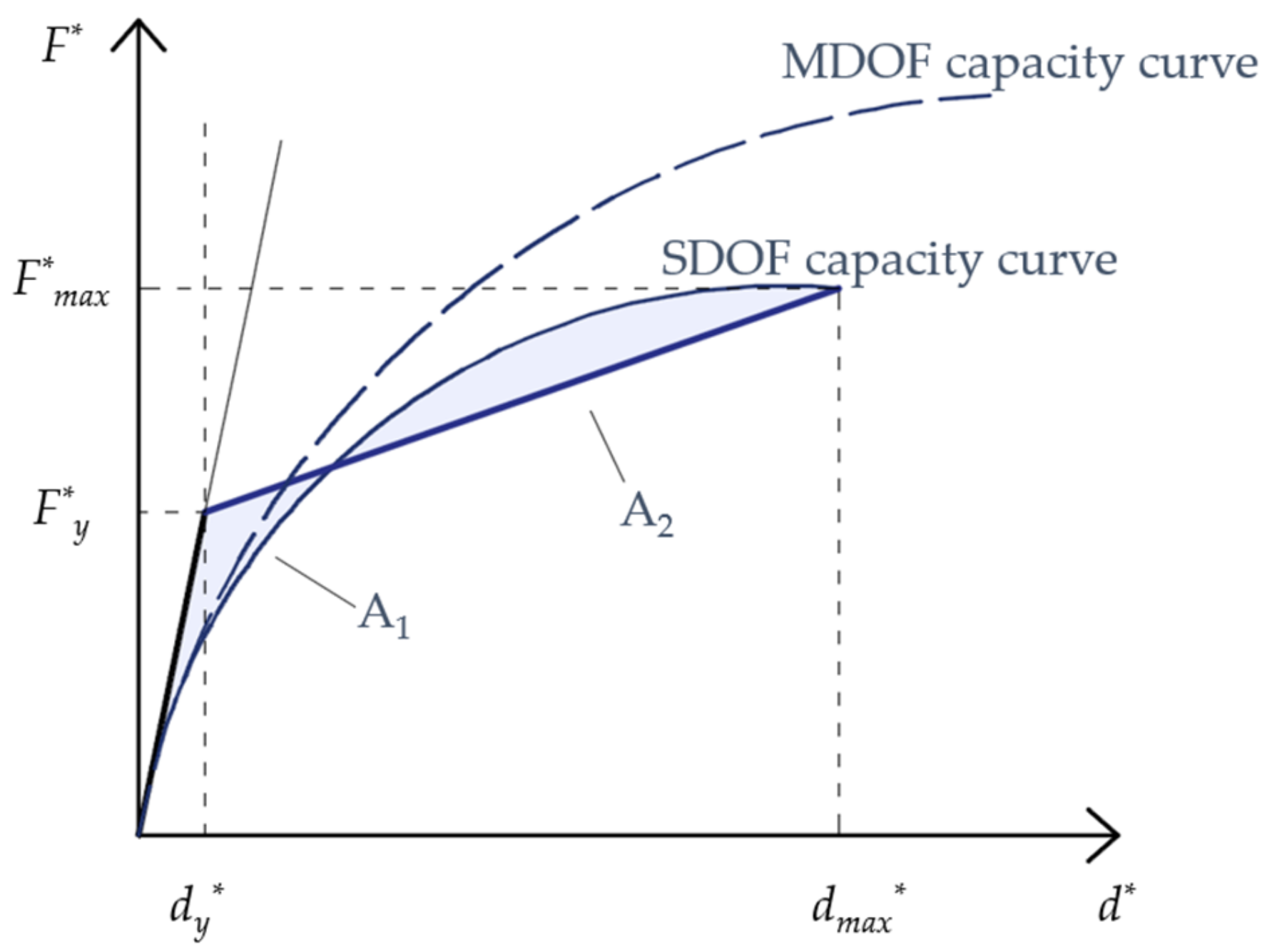
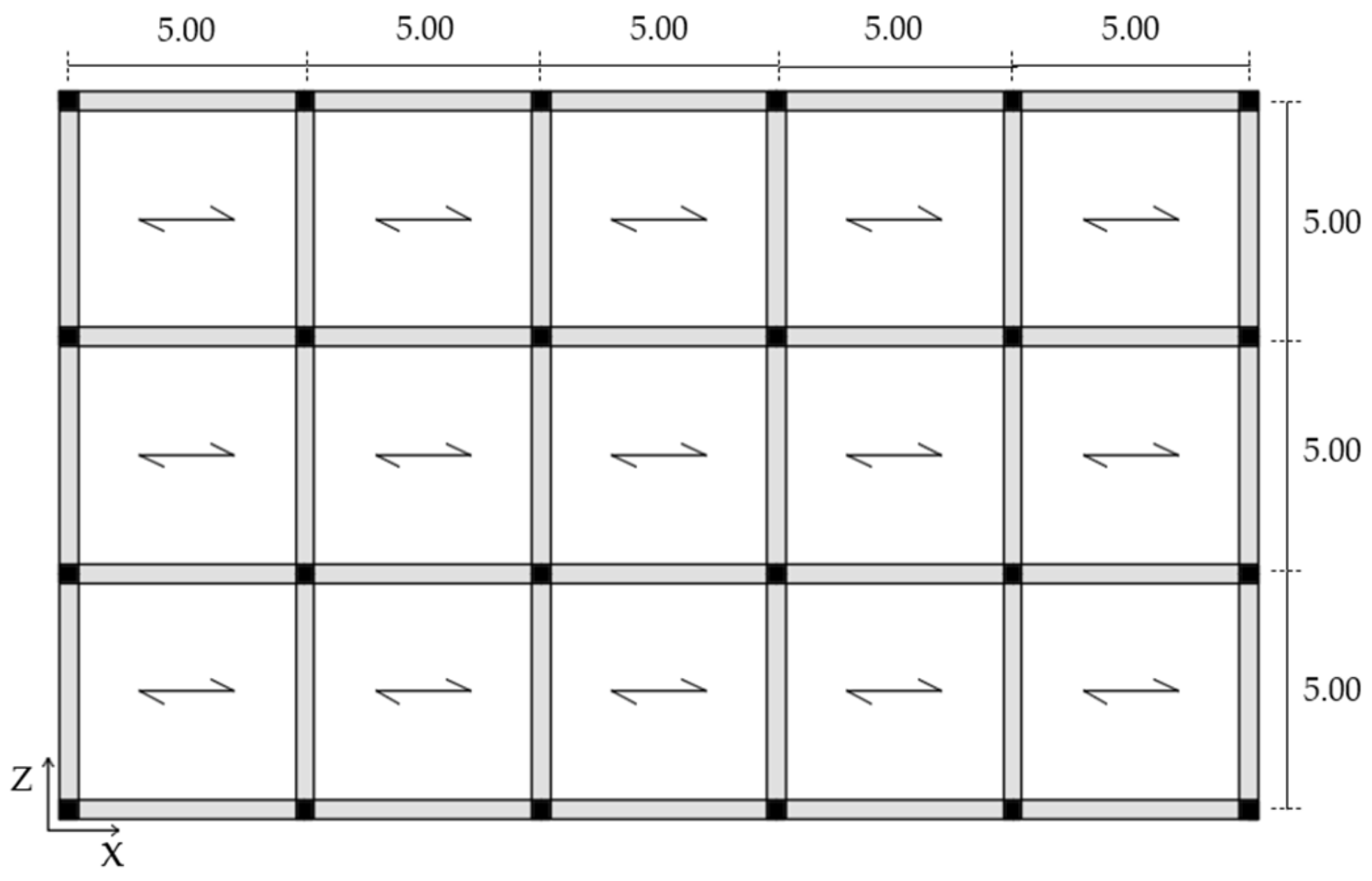

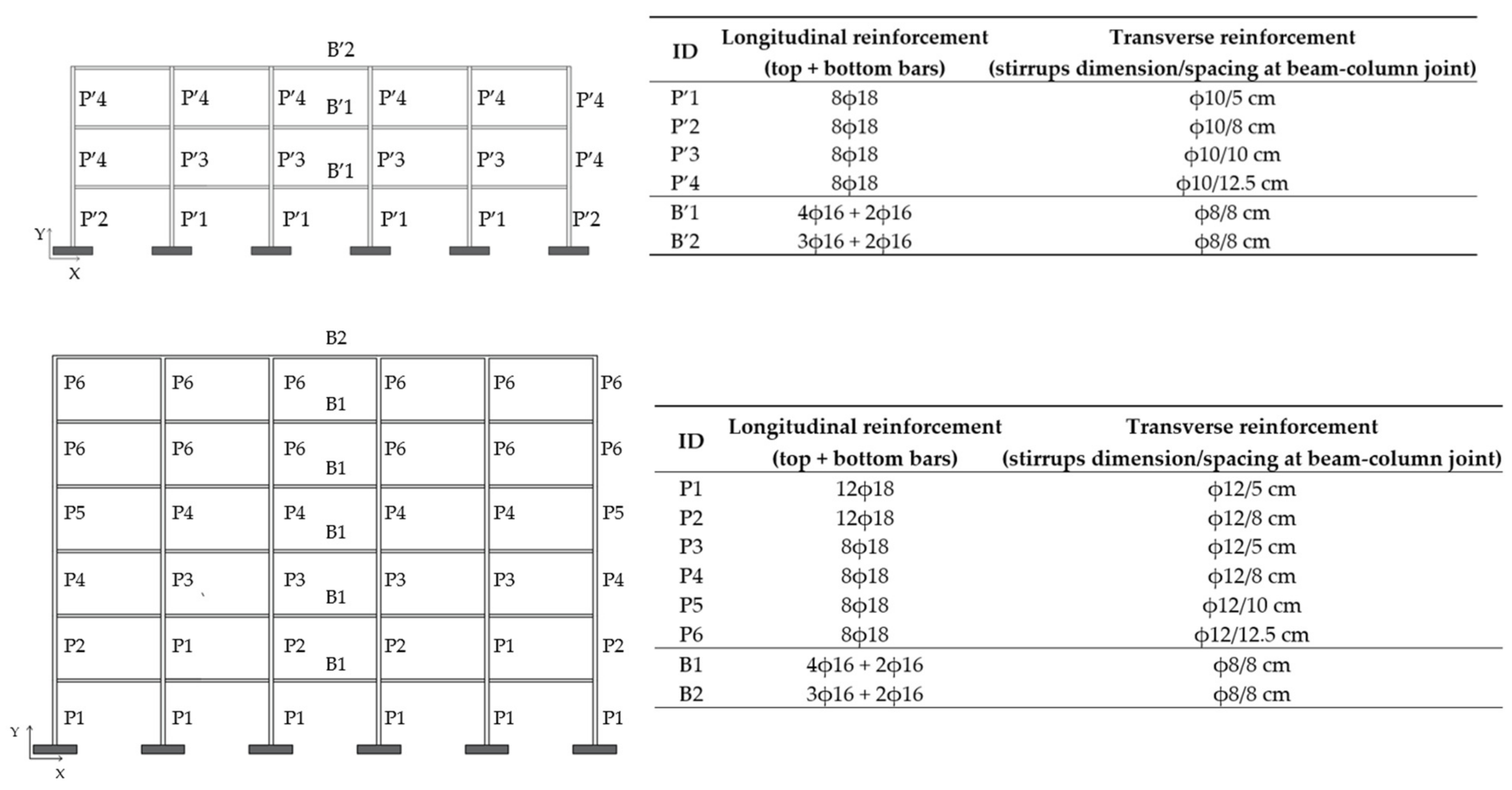

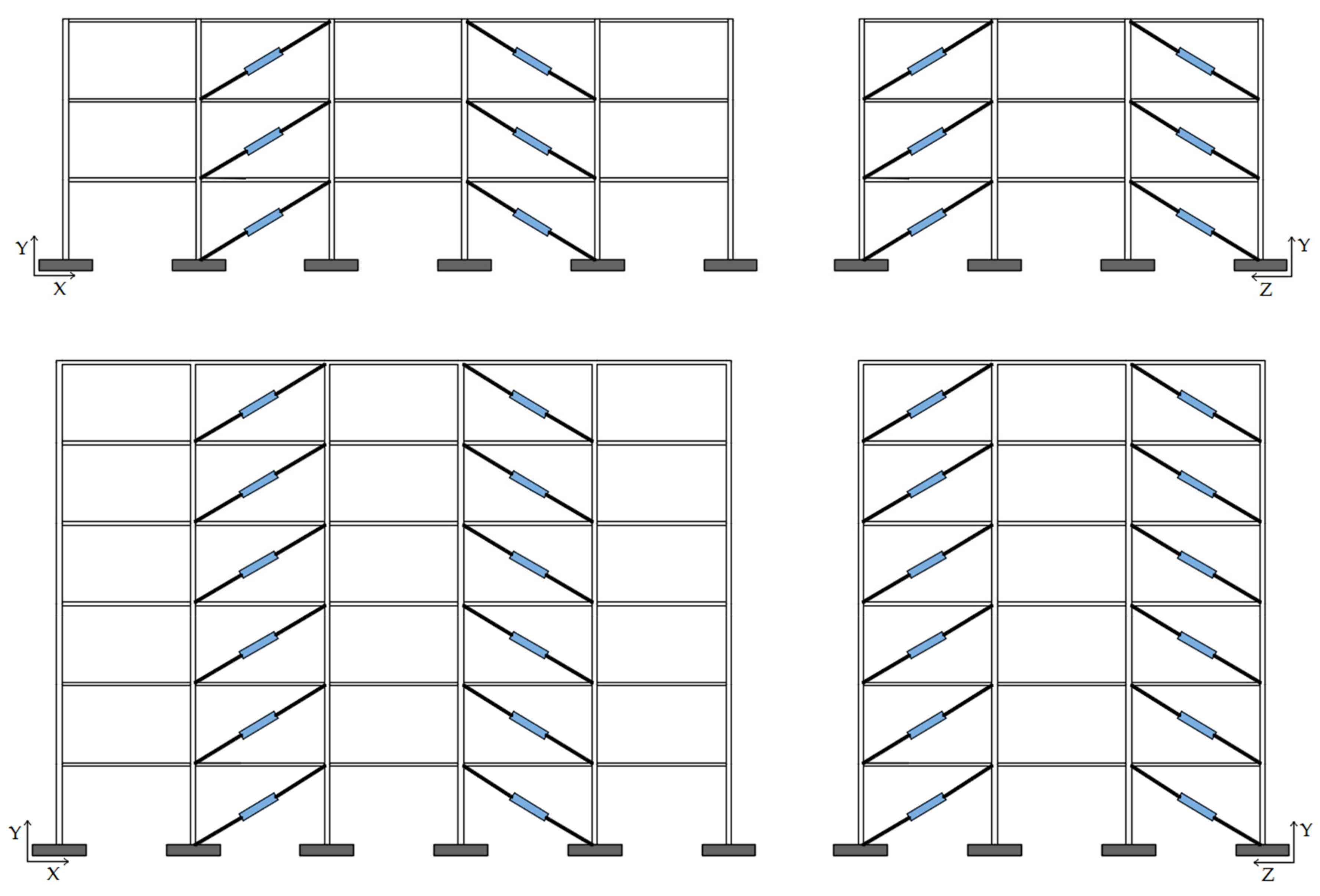

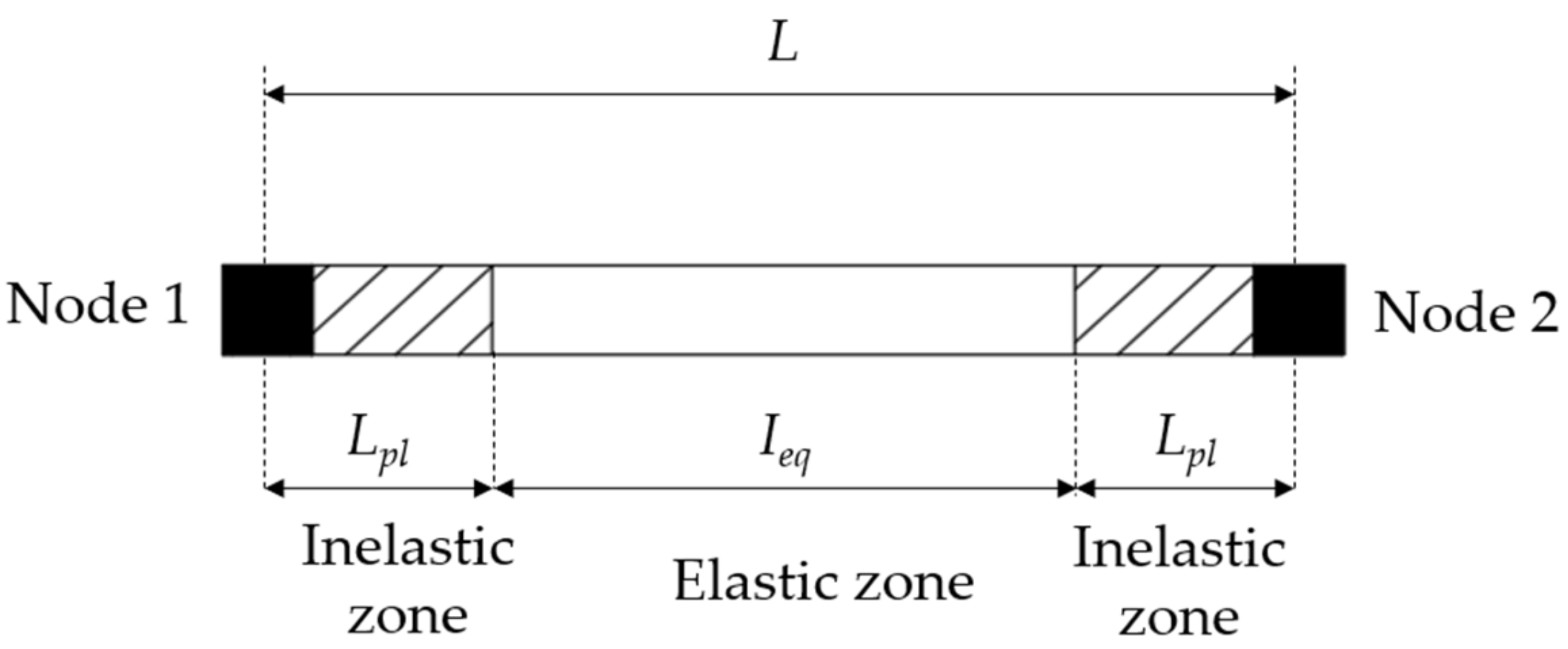




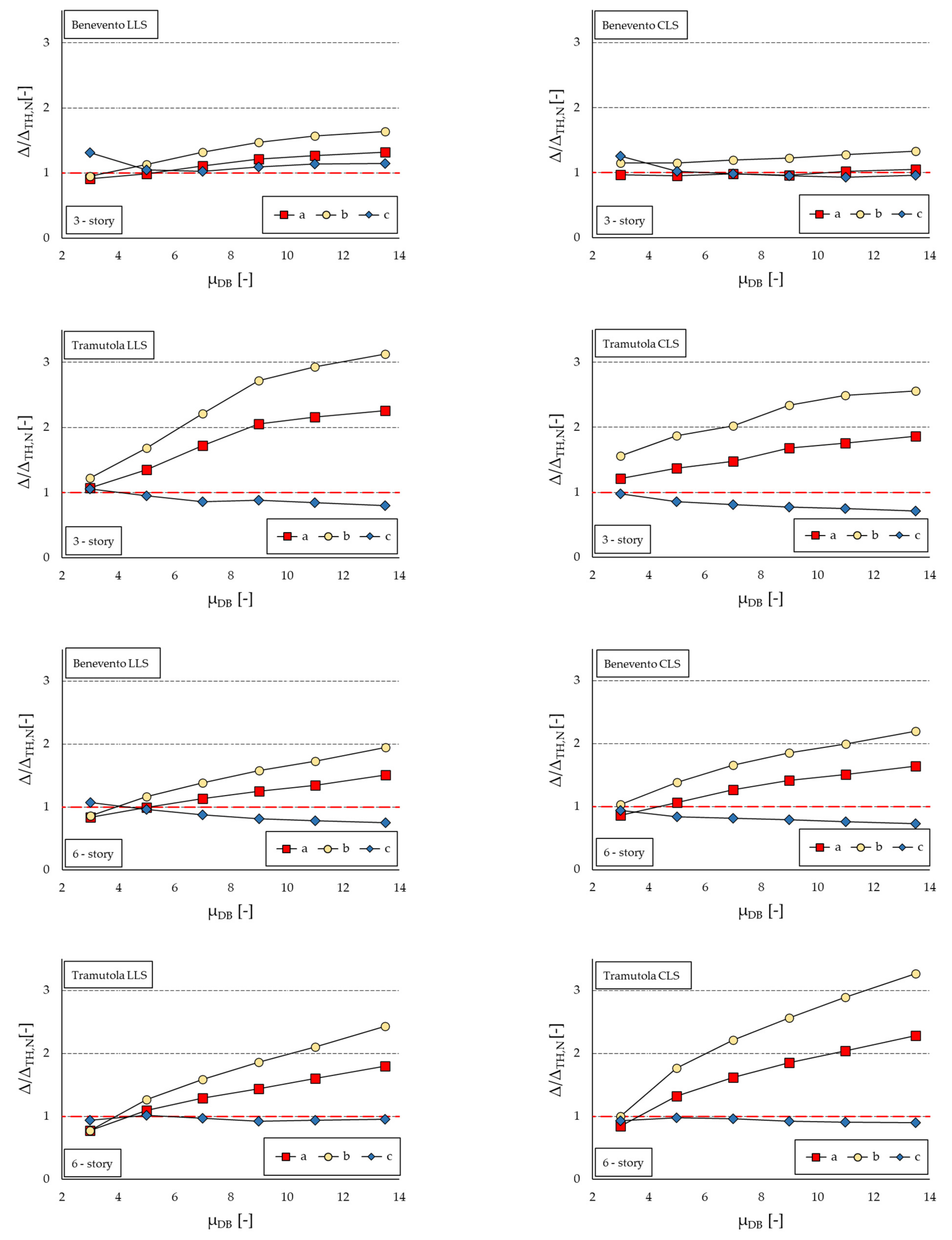
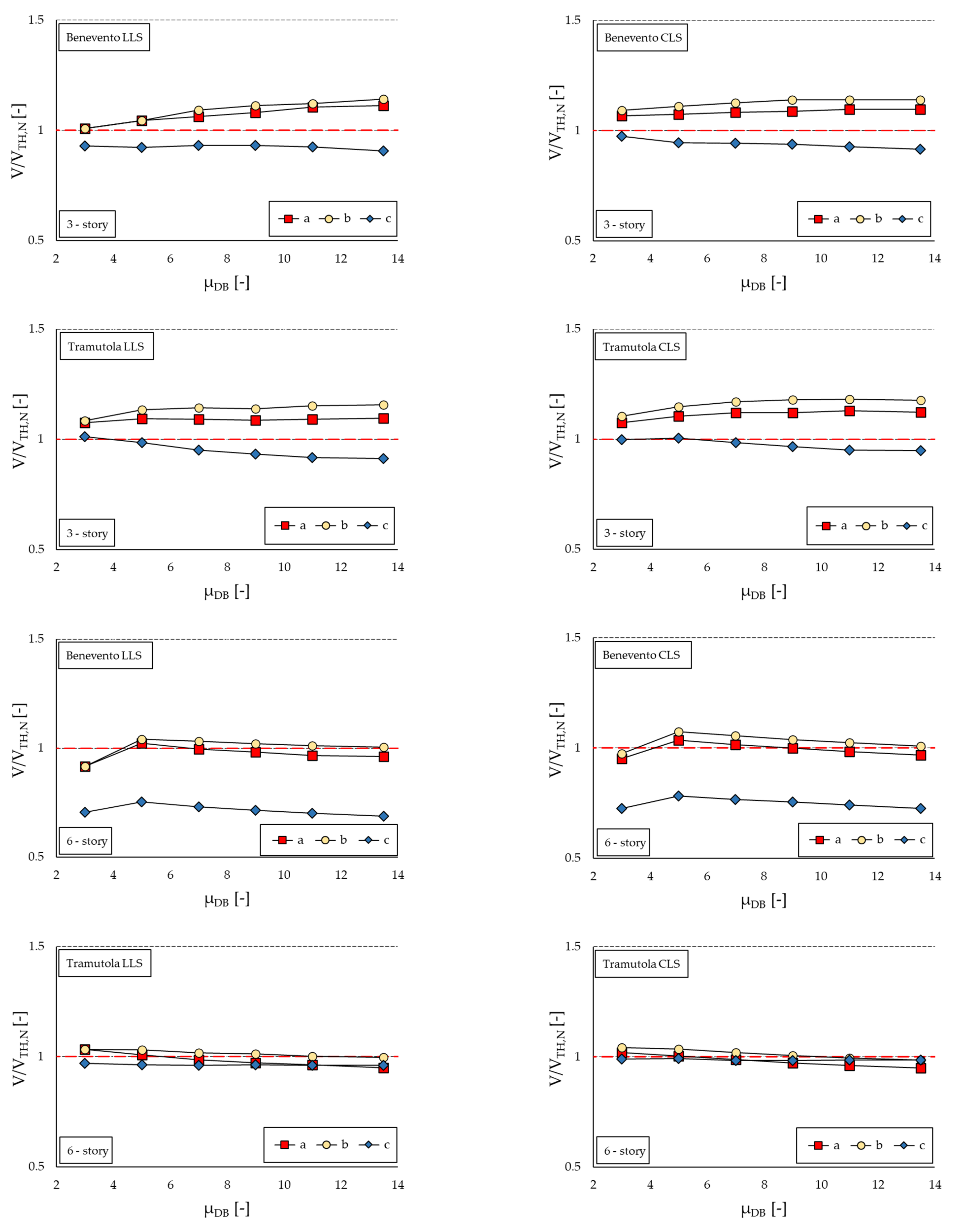
| μD (-) | KB/KD = 2 | KB/KD = 3 | KB/KD = 4 | KB/KD = 5 | ||||
|---|---|---|---|---|---|---|---|---|
| μDB (-) | ξDB (%) | μDB (-) | ξDB (%) | μDB (-) | ξDB (%) | μDB (-) | ξDB (%) | |
| 4 | 3.0 | 42.4 | 3.3 | 44.1 | 3.4 | 44.9 | 3.5 | 45.5 |
| 6 | 4.3 | 49.0 | 4.8 | 50.3 | 5.0 | 50.9 | 5.2 | 51.3 |
| 8 | 5.7 | 52.4 | 6.3 | 53.5 | 6.6 | 54.0 | 6.8 | 54.3 |
| 10 | 7.0 | 54.6 | 7.8 | 55.4 | 8.2 | 55.9 | 8.5 | 56.2 |
| 12 | 8.3 | 56.0 | 9.3 | 56.8 | 9.8 | 57.2 | 10.2 | 57.4 |
| 14 | 9.7 | 57.1 | 10.8 | 57.7 | 11.4 | 58.1 | 11.8 | 58.3 |
| 16 | 11.0 | 57.9 | 12.3 | 58.5 | 13.0 | 58.8 | 13.5 | 58.9 |
| 4 | 3.0 | 42.4 | 3.3 | 44.1 | 3.4 | 44.9 | 3.5 | 45.5 |
| 6 | 4.3 | 49.0 | 4.8 | 50.3 | 5.0 | 50.9 | 5.2 | 51.3 |
Disclaimer/Publisher’s Note: The statements, opinions and data contained in all publications are solely those of the individual author(s) and contributor(s) and not of MDPI and/or the editor(s). MDPI and/or the editor(s) disclaim responsibility for any injury to people or property resulting from any ideas, methods, instructions or products referred to in the content. |
© 2024 by the authors. Licensee MDPI, Basel, Switzerland. This article is an open access article distributed under the terms and conditions of the Creative Commons Attribution (CC BY) license (https://creativecommons.org/licenses/by/4.0/).
Share and Cite
Bruschi, E.; Quaglini, V. Assessment of Non-Linear Analyses of RC Buildings Retrofitted with Hysteretic Dampers According to the Italian Building Code. Appl. Sci. 2024, 14, 2684. https://doi.org/10.3390/app14072684
Bruschi E, Quaglini V. Assessment of Non-Linear Analyses of RC Buildings Retrofitted with Hysteretic Dampers According to the Italian Building Code. Applied Sciences. 2024; 14(7):2684. https://doi.org/10.3390/app14072684
Chicago/Turabian StyleBruschi, Eleonora, and Virginio Quaglini. 2024. "Assessment of Non-Linear Analyses of RC Buildings Retrofitted with Hysteretic Dampers According to the Italian Building Code" Applied Sciences 14, no. 7: 2684. https://doi.org/10.3390/app14072684
APA StyleBruschi, E., & Quaglini, V. (2024). Assessment of Non-Linear Analyses of RC Buildings Retrofitted with Hysteretic Dampers According to the Italian Building Code. Applied Sciences, 14(7), 2684. https://doi.org/10.3390/app14072684






